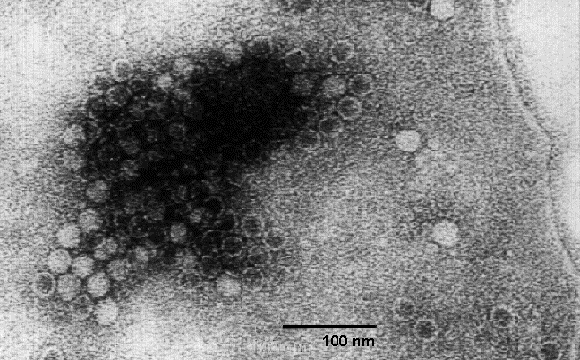What is Feline Panleukopenia Virus FPV?
Feline Panleukopenia Virus (FPV), as it is often called, is an extremely contagious virus of the parvovirus group, with a high mortality rate, which often targets kittens. Areas with large populations of unvaccinated cats, such as feral colonies or homes of “cat collectors,” are particularly susceptible to Panleukopenia outbreaks.
The feline distemper virus amounts to a single strand of DNA surrounded by a protein coating. It is extremely stable in the environment, which leads to its characterization as ubiquitous (everywhere). It can last a year indoors at room temperature and survives freezing. It also survives treatment with such common disinfectants as alcohol and iodine. Fortunately, a 10-minute soak in bleach (diluted 1 part bleach in 32 parts water) exposure will kill it.
Virtually every cat will be exposed to this virus.
Infection occurs when the virus enters the body through the mouth or nose. Whether illness results or not depends on the immunity in the victim vs. the number of individual virus particles entering the body.
The feline distemper virus is a parvovirus. Many people are familiar with this term as parvovirus infection is a concern for dogs, especially puppies. In fact, canine parvovirus is closely related to the feline panleukopenia virus and much of the information regarding canine parvovirus holds true for feline distemper. The feline distemper virus, however, is more difficult to remove from the environment and more lethal than its canine counterpart.
How is Feline Panleukopenia Transmitted?:
The feline Panleukopenia virus (FVP) is extremely hardy and may survive for months, and even years. It is easily transmitted through contact, either cat-to-cat, or by human-to-cat :
- Shared food and water bowls, litter pans, bedding
- Mutual grooming
- Fleas, during the active stage
- In utero, from an infected queen
- Human handling can transfer the FVP virus from one cat to another, by contact through hands, clothing, and shoes.
An infected cat sheds large amounts of virus in all body secretions including feces, vomit, urine, saliva, and mucus. The virus persists long after evidence of the original body secretion has faded away. The virus enters the cat’s body and proceeds to infect rapidly dividing cells. The lymph nodes of the throat are first to be affected and from there, over the next 2 to 7 days, the virus rushes to the bone marrow and intestine.
In the bone marrow, the virus suppresses production of the entire white blood cell line, hence the term panleukopenia (literally, all-white-shortage). The white blood cells are the immune cells needed to fight the infection and without them the victim is completely vulnerable to the advance of the virus.
In the intestine, the virus causes ulceration that leads to diarrhea and life-threatening dehydration as well as bacterial infection because the barrier between the body and intestinal bacteria is lost. The patient dies from either dehydration or secondary bacterial infection.
Because most cats are exposed to this virus to some extent, it is unusual for a kitten to have no immunity whatsoever. Furthermore, the vaccine is so effective that even one dose can provide long-lasting protection. As a result, infection is largely limited to unvaccinated younger animals kept in groups, which corresponds to exposure to amounts of virus large enough to overwhelm their partial immunity. Mortality of sick cats is typically considered 90%, though it has been said that a kitten who survives the first 5 days is likely to survive the infection.
A specific syndrome occurs if infection occurs during pregnancy. If infection occurs in mid or early pregnancy, the kittens simply abort. If the kittens are fairly far along, the cerebellum is involved, leading to cerebellar hypoplasia. The cerebellum is the part of the central nervous system that coordinates balance and movement, enabling one to walk or run on an uneven surface without consciously thinking about it. Without a normal cerebellum, the kitten is born with marked intention tremors: whenever he focuses on purposeful movement, he tremors so much that normal movement is impossible.
What Are the Symptoms of Feline Panleukopenia Virus (FPV)?
The initial symptoms are also found with many other diseases, and always indicate the need for a veterinary examination.
- Vomiting
- diarrhea
- Depression
- Disinterest in food and water
- Appearance of the “third eyelid,” or haw, in the inner corner of the eye
- Lack of grooming, evidenced by dull, rough coat
- Evidence of abdominal pain
- A “hunched over” postural appearance
How is Panleukopenia Virus (FPV) Diagnosed and Treated?:
A tentative diagnosis may be made by the history of symptoms and clinical signs such as fever or a drop in the white blood cell count. The latter symptoms may vary from cat to cat, and depending on the stage of the infection. A finding of antibodies to the virus in the blood will confirm diagnosis.
Treatment involves alleviating vomiting and diarrhea, to prevent subsequent dehydration, along with steps to prevent secondary bacterial infections, until the cat’s natural immune system takes over.
Prevention of Feline Panleukopenia:
When born to a queen with feline Panleukopenia virus FPV antibodies, kittens will have a natural immunity for the first eight to ten weeks. After that period, vaccinations should be started. The FPV vaccine is often combined in “3-way” shots, which also include protection against feline herpesvirus 1(FSV1), and feline calicivirus (FCV). Kittens receive a series of followup vaccines, and all adult cats should be vaccinated every one to three years for FCV, depending on the kind of vaccine used.
The feline Panleukopenia virus FPV vaccine is not recommended for kittens under eight weeks of age, since their natural immunity may interfere with the efficacy of the feline Panleukopenia virus FPV vaccine. An FVP antiserum can be used to immunize kittens under eight weeks, which have been exposed to the FPV virus, and also for older, unprotected cats who have been exposed.
Preventing Further Outbreaks:
Since the feline Panleukopenia virus FPV virus is so hardy, and can persist in the environment for months or years, a thorough disinfection of the entire premises needs to be made after an outbreak of feline Panleukopenia virus (FPV) in a home shared by cats. The only disinfectant presently acknowleded is a dilute bleach solution, of 1:9 (one part bleach to nine parts water.)
Although feline Panleukopenia Virus (FPV) is considered a “dread disease” of cats, with routine vaccinations, isolation of cats new to the household until they have been tested and vaccinated, and routine sanitary precautions, the average multi-cat household should remain safe from this disease.

